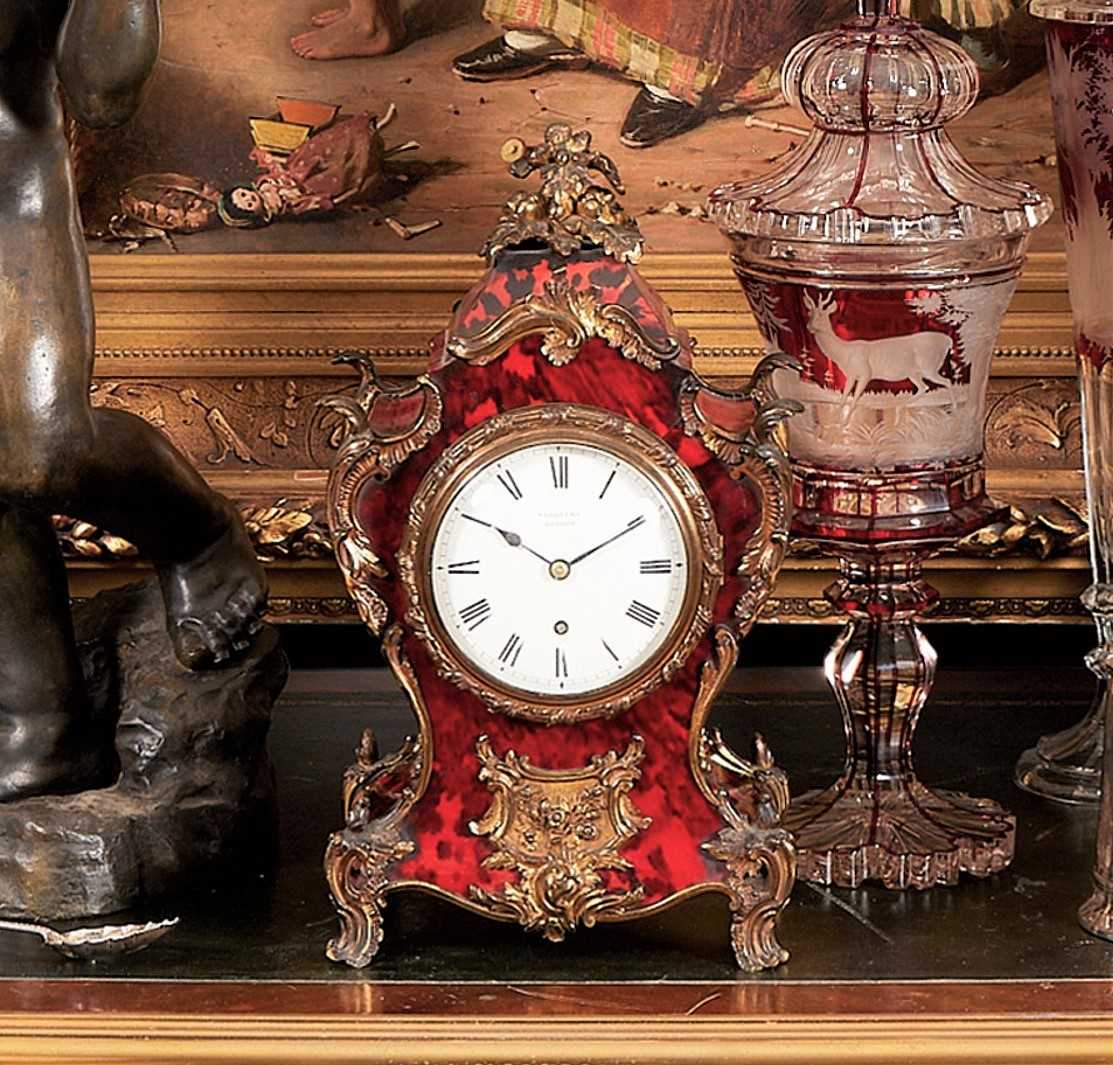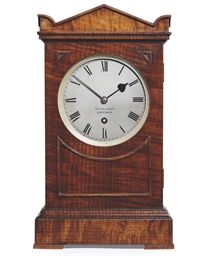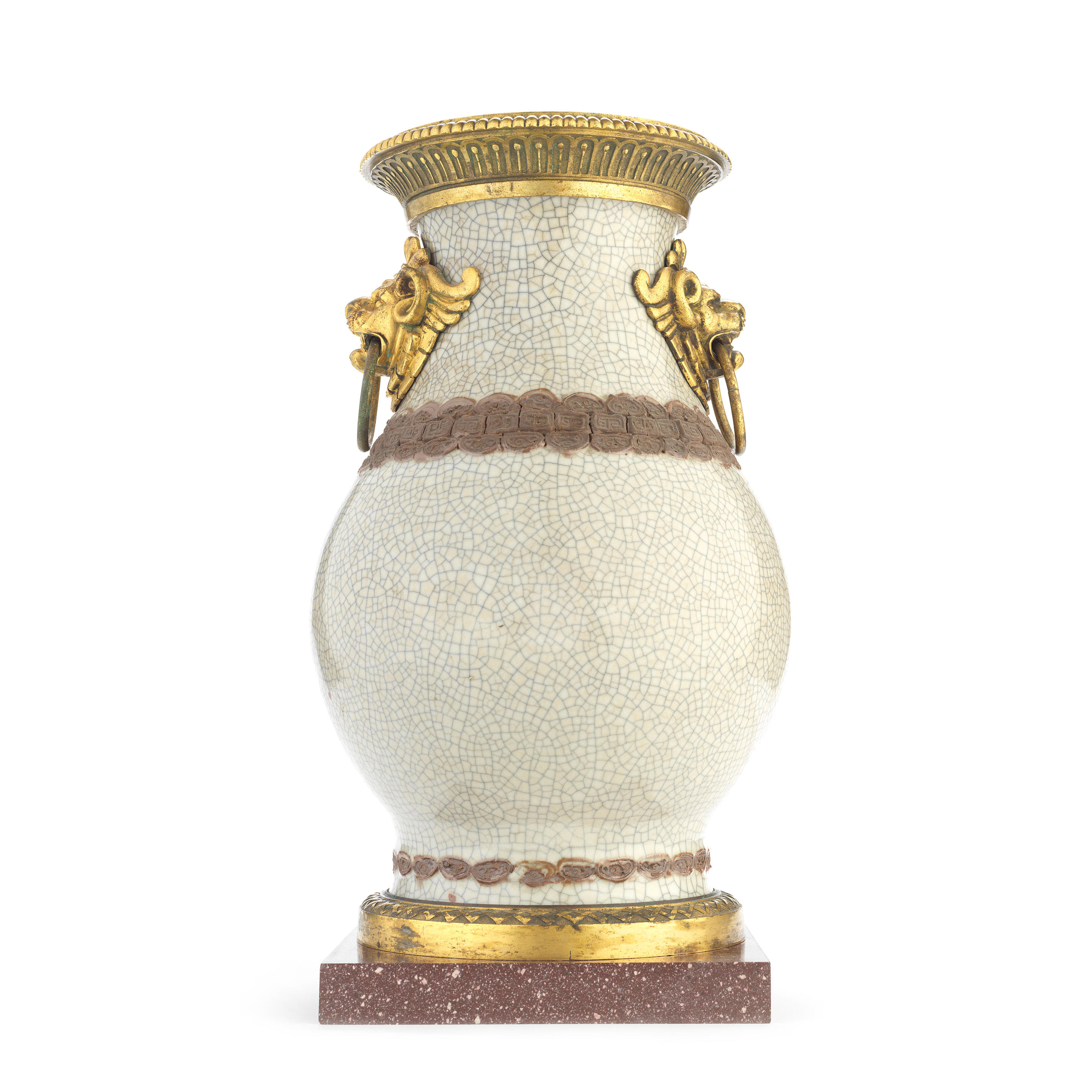BENJAMIN LEWIS VULLIAMY (1780-1854): AN EXCEPTIONALLY RARE GILT BRONZE AND ROUGE GRIOTTE MARBLE STRIKING MANTEL CLOCK, NO. 729 the case with a stepped rectangular plinth in the form of a domestic Pompeian altar (arula) applied with an ormolu mount depicting the heads of Hercules and Bacchus raised on a plinth, the drum case resting on a carved and gilt mounted ionic volute capital, surmounted by a model of a gilt bronze eagle with wings outstretched, with a gilt bezel cast as a serpent, the gilt dial with Roman numerals signed 'VULLIAMY LONDON', with gilt centre and blued steel hands, with rise and fall regulation winding square to the top, the fine twin chain fusee movement with circular plates united by five pillars, the backplates numbered 729 and signed 'Vullilamy LONDON', with anchor escapement and rise and fall regulation, striking the hours on a bell, with pendulum, 31cm high PLEASE NOTE: This lot will be on display at our South Kensington branch from 29th May until it goes on view at Chiswick on 7th June. Condition: The clock is currently running and striking but not fully tested or guaranteed. Provenance: Consigned by a descendant of Henry Stormont Finch-Hatton, 13th Earl of Winchilsea and 8th Earl of Nottingham. This clock has been in their family for at least three generations, the present owner's grandmother, Lady Gladys Margaret Williams (née Finch-Hatton) (1882-1964) was daughter of Henry Stormont Finch-Hatton. The Finch-Hatton family resided at Haverholme Priory in the 19th century, having employed H.E Kendal in 1830 to build a new country house on the site of the original 1780's house in the fashionable Gothic style. The Finch-Hatton's sold the house in 1926 when it was sold to an American lady who planned to dismantle the house brick by brick and re-build it in America. However as the first load of cargo was about the leave the docks at Liverpool, the new buyer was killed in a train crash. The stones were reputedly used to build the new docks in Liverpool, leaving the remains of ruins which still stand today at Haverholme Priory. We do not know the exact history of the clock during the 19th century but it is tempting to speculate that Henry Finch-Hatton acquired this elegant clock for his re-modelled home in 1830. This quite exceptional clock was made by the most prestigious horologist of the early 19th century and Clockmaker to the King, Benjamin Lewis Vulliamy It is of a design which can be seen in other examples in the Royal Collection at Buckingham Palace, however this clock is particularly rare and important because it is one of the few decorative mantel clocks that Vulliamy ever produced that is a striking clock rather than a timepiece that simply tells the time. It features a fine twin fusee movement which strikes the hours on a bell, a feature very rarely seen in this type of marble and ormolu clock that Vulliamy was famous for in the first quarter on the 19th century. There are numerous examples of his work in the Royal Collection, and the two timepieces of similar form to the present clock are Inv. No. RCIN 2885, a rose marble mantel clock with patinated bronze eagle atop and featuring an ormolu anthemion mount to the marble case, the movement numbered 935. A further example in the Royal Collection which does not have a mount to the marble case but is, like the present clock, of Rouge Griotte marble and features a patinated bronze eagle rather than a gilt bronze version, is Inv. No. RCIN 30258 and is numbered 936. These examples are typical of his work and are both single fusee timepieces rather than striking clocks with a bell. The numbering of these royal clocks suggest they were designed, manufactured and supplied in the mid 1820's by Benjamin Lewis Vulliamy who inherited his father's business in 1811. Auction Comparable: A timepiece of similar design, of Rouge marble surmounted by a gilt bronze eagle and with a classical relief to the base, Vulliamy number 753, was sold at Bonhams, London, 11 D
BENJAMIN LEWIS VULLIAMY (1780-1854): AN EXCEPTIONALLY RARE GILT BRONZE AND ROUGE GRIOTTE MARBLE STRIKING MANTEL CLOCK, NO. 729 the case with a stepped rectangular plinth in the form of a domestic Pompeian altar (arula) applied with an ormolu mount depicting the heads of Hercules and Bacchus raised on a plinth, the drum case resting on a carved and gilt mounted ionic volute capital, surmounted by a model of a gilt bronze eagle with wings outstretched, with a gilt bezel cast as a serpent, the gilt dial with Roman numerals signed 'VULLIAMY LONDON', with gilt centre and blued steel hands, with rise and fall regulation winding square to the top, the fine twin chain fusee movement with circular plates united by five pillars, the backplates numbered 729 and signed 'Vullilamy LONDON', with anchor escapement and rise and fall regulation, striking the hours on a bell, with pendulum, 31cm high PLEASE NOTE: This lot will be on display at our South Kensington branch from 29th May until it goes on view at Chiswick on 7th June. Condition: The clock is currently running and striking but not fully tested or guaranteed. Provenance: Consigned by a descendant of Henry Stormont Finch-Hatton, 13th Earl of Winchilsea and 8th Earl of Nottingham. This clock has been in their family for at least three generations, the present owner's grandmother, Lady Gladys Margaret Williams (née Finch-Hatton) (1882-1964) was daughter of Henry Stormont Finch-Hatton. The Finch-Hatton family resided at Haverholme Priory in the 19th century, having employed H.E Kendal in 1830 to build a new country house on the site of the original 1780's house in the fashionable Gothic style. The Finch-Hatton's sold the house in 1926 when it was sold to an American lady who planned to dismantle the house brick by brick and re-build it in America. However as the first load of cargo was about the leave the docks at Liverpool, the new buyer was killed in a train crash. The stones were reputedly used to build the new docks in Liverpool, leaving the remains of ruins which still stand today at Haverholme Priory. We do not know the exact history of the clock during the 19th century but it is tempting to speculate that Henry Finch-Hatton acquired this elegant clock for his re-modelled home in 1830. This quite exceptional clock was made by the most prestigious horologist of the early 19th century and Clockmaker to the King, Benjamin Lewis Vulliamy It is of a design which can be seen in other examples in the Royal Collection at Buckingham Palace, however this clock is particularly rare and important because it is one of the few decorative mantel clocks that Vulliamy ever produced that is a striking clock rather than a timepiece that simply tells the time. It features a fine twin fusee movement which strikes the hours on a bell, a feature very rarely seen in this type of marble and ormolu clock that Vulliamy was famous for in the first quarter on the 19th century. There are numerous examples of his work in the Royal Collection, and the two timepieces of similar form to the present clock are Inv. No. RCIN 2885, a rose marble mantel clock with patinated bronze eagle atop and featuring an ormolu anthemion mount to the marble case, the movement numbered 935. A further example in the Royal Collection which does not have a mount to the marble case but is, like the present clock, of Rouge Griotte marble and features a patinated bronze eagle rather than a gilt bronze version, is Inv. No. RCIN 30258 and is numbered 936. These examples are typical of his work and are both single fusee timepieces rather than striking clocks with a bell. The numbering of these royal clocks suggest they were designed, manufactured and supplied in the mid 1820's by Benjamin Lewis Vulliamy who inherited his father's business in 1811. Auction Comparable: A timepiece of similar design, of Rouge marble surmounted by a gilt bronze eagle and with a classical relief to the base, Vulliamy number 753, was sold at Bonhams, London, 11 D















Testen Sie LotSearch und seine Premium-Features 7 Tage - ohne Kosten!
Lassen Sie sich automatisch über neue Objekte in kommenden Auktionen benachrichtigen.
Suchauftrag anlegen